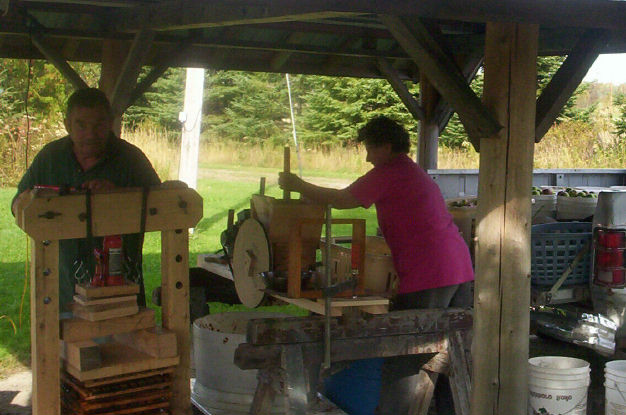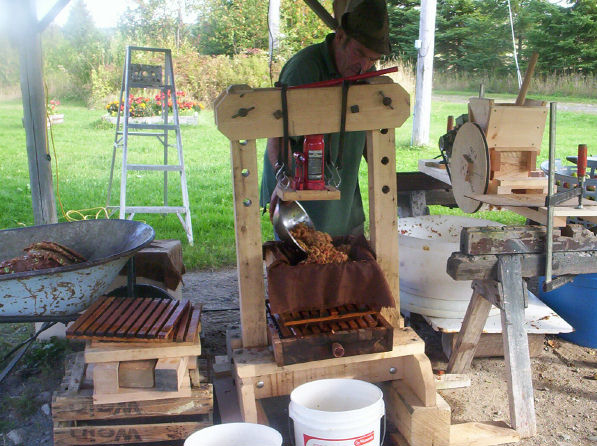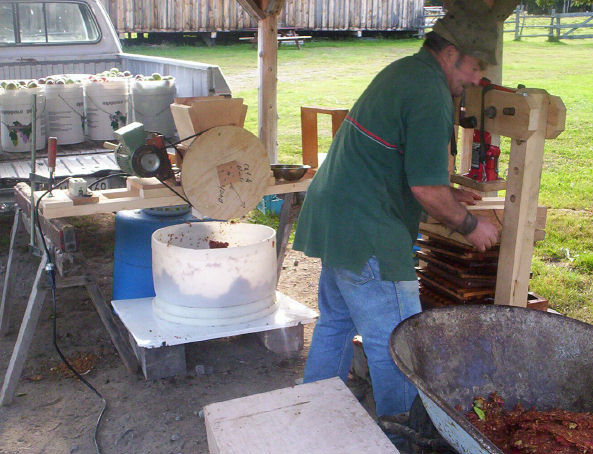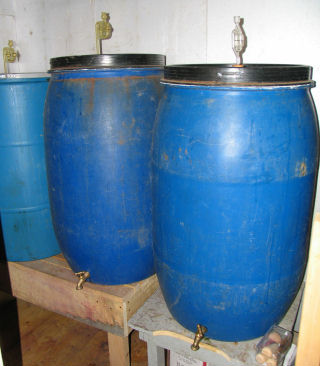
Eventually, my dad built his own press. For a grinding / chopping apparatus, my parents asked me to try to find one. I ended up building an apple grinder. Now, with sturdy home made apple press and apple grinder, the cider operation really works, and the juice yield is much better.
I'm typically not around in the fall when my parents make the cider, but my mom took some pictures, and I figure these might be useful to anyone contemplating making their own apple cider as well.

In this picture, my dad is operating the press on the left, while my mom is operating the apple grinder I built. My dad made a tool for pushing the apples into the grinder, which my mom is using. Makes grinding up the apples go much faster.

In this shot, my dad is filling the press with ground apples. The press doesn't use a barrel. Instead, there is alternating wooden grates, and apples wrapped in cloth. This is done by putting a frame on top, putting the cloth in, filling the frame with apples, folding the cloth over the apples, and removing the frame. Then the next wooden grid is added, and the steps repeated.
The advantage of this system is that it's easier for the juice to escape by flowing between the slats of the wooden grids. The downside is that it's more work. Grinding the apples went faster than pressing them, so my mom had to take breaks from grinding apples so my dad could catch up pressing them. It's not a good idea to leave the apple grounds sitting around for too long.
Note the slabs of apple mush in the wheelbarrow on the left. With the apples thoroughly pressed, the leftovers stick together in pancake like slabs.
Also note the wooden box with a spout on it on the bottom of the press. The juice
runs down the outside of the load in the press, into the box, and out the spout,
and into a bucket in front.
 Another shot of my dad working the press. This is my dad adding another
block of wood, because the stroke of the hydraulic press is not long enough to fully
compress the apples in one go. The Jack is a 6 ton hydraulic jack. Much more
pressure than a screw type press can deliver. The press frame is made of solid maple.
Another shot of my dad working the press. This is my dad adding another
block of wood, because the stroke of the hydraulic press is not long enough to fully
compress the apples in one go. The Jack is a 6 ton hydraulic jack. Much more
pressure than a screw type press can deliver. The press frame is made of solid maple.

After a day and a half of work, my parents produced about 220 liters of apple juice.
They let it ferment in plastic barrels like these. Most people use yeast. My mom
would just leave the juice in open containers for a while to pick up wild yeast
from the air before sealing the containers.
The taps on the bottom of the barrels is a water tap with a special bushing, from
Lee Valley Tools to mount it in the barrel.
The home made apple cider is very good - I have some every time I visit my parents. And the best part is, it was completely free - and not a dollar in alcohol taxes!
When my parents have too much cider, they let some of it turn into vinegar, which
of course is all natural apple cider vinegar. This happens just by letting the cider sit in
the open. The required bacteria for this transformation occurs naturally, and uncovered
cider will get them eventually. This is why the alcohol fermentation is always done in sealed
containers with an air trap to let the carbon dioxide out. If you let any old wild bacteria
from the air in there, you always end up with vinegar. Wooden barrels are risky that
way because the wrong kind of bacteria can get lodged in the wood, and it's difficult
(or impossible) to get rid of.